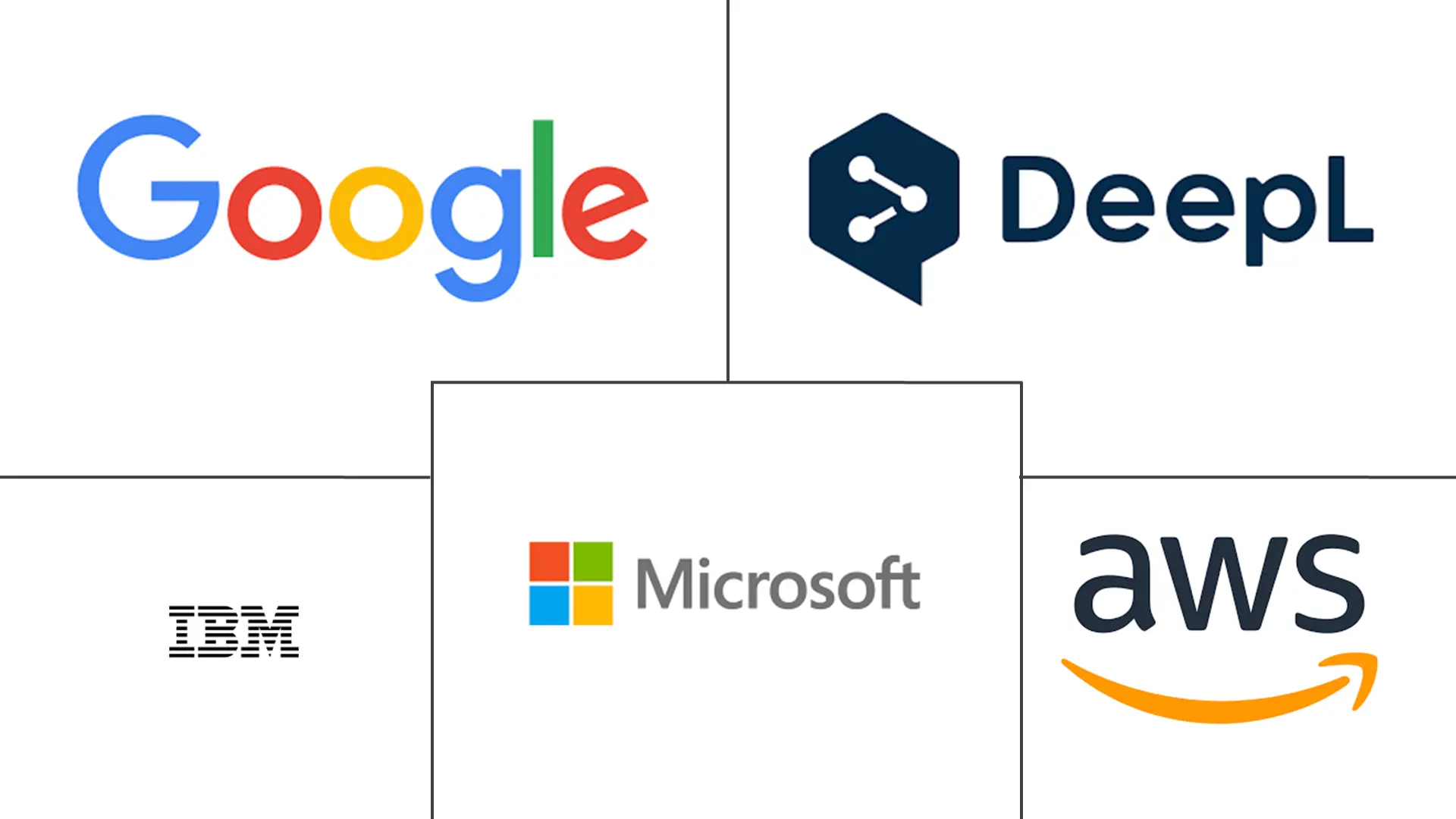Machine Translation Market Size and Share
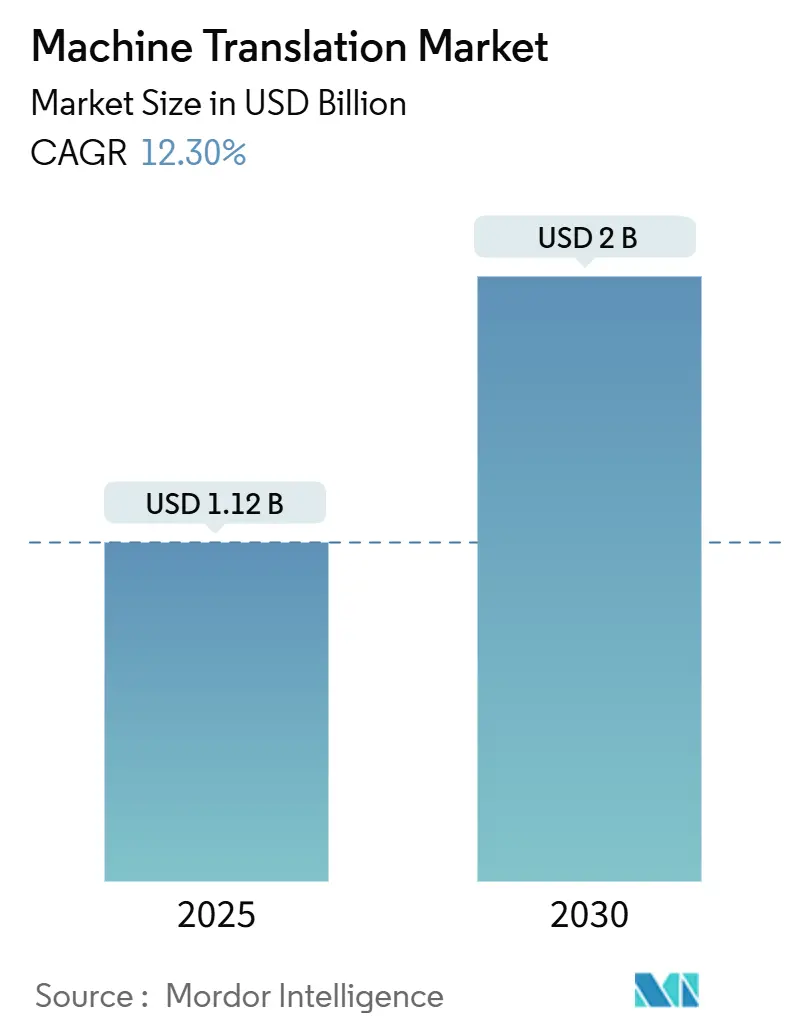
Machine Translation Market Analysis by Mordor Intelligence
The Machine Translation Market size is estimated at USD 1.12 billion in 2025, and is expected to reach USD 2 billion by 2030, at a CAGR of 12.30% during the forecast period (2025-2030). Adoption accelerates as enterprises pivot from rule-based tools toward transformer-based neural models that boost BLEU scores, cut post-editing workloads, and integrate easily with cloud content workflows. Heightened digitization mandates, stringent multilingual compliance rules, and the ability of vendors to embed MT APIs into e-commerce, CRM, and mobile platforms expand procurement budgets across sectors. Accurate, domain-tuned neural engines now serve as brand-experience safeguards, especially where mistranslations jeopardize safety or legal standing. Competition increasingly revolves around demonstrable accuracy gains in regulated verticals such as healthcare and automotive, where even minor errors invite penalties under device and vehicle guidelines.
Key Report Takeaways
- By technology, Neural Machine Translation led with 48.67% of the machine translation market share in 2024; Hybrid and Adaptive MT posts the fastest 14.23% CAGR through 2030.
- By deployment, cloud-based offerings captured 62.34% revenue in 2024 while also recording an 11.87% CAGR forecast to 2030.
- By end-user vertical, IT and Telecom commanded 26.45% share of the machine translation market size in 2024, while Healthcare and Life Sciences advance at a 13.89% CAGR to 2030.
- By geography, North America held 36.78% revenue in 2024, whereas the Asia Pacific is set to expand at a 13.40% CAGR through 2030.
Global Machine Translation Market Trends and Insights
Drivers Impact Analysis
| Driver | (~) % Impact on CAGR Forecast | Geographic Relevance | Impact Timeline |
|---|---|---|---|
| Growing demand for content localization | +2.8% | Global, with concentration in North America and EU | Medium term (2-4 years) |
| Need for cost-efficient, high-speed translation | +2.1% | Global, particularly APAC emerging markets | Short term (≤ 2 years) |
| Expansion of cross-border e-commerce platforms | +1.9% | Global, led by North America and APAC | Medium term (2-4 years) |
| Transformer-based MT breakthroughs | +2.3% | Global, with early adoption in North America and EU | Long term (≥ 4 years) |
| Mandatory multilingual compliance under EU AI Act | +1.4% | EU primary, spillover to global enterprises | Medium term (2-4 years) |
| Real-time in-game voice translation uptake | +1.2% | Global, concentrated in APAC gaming markets | Long term (≥ 4 years) |
| Source: Mordor Intelligence | |||
Growing Demand for Content Localization
Enterprises now require simultaneous, context-aware adaptation across websites, apps, chatbots, and social media rather than isolated page translations. Neural engines trained on brand-specific corpora safeguard tone and terminology, reducing editorial loops and time-to-market. Shopify merchants illustrate the shift by deploying LangShop to localize product descriptions, prices, and checkout flows in minutes [1]Shopify, “LangShop Language Translation App,” shopify.com. Hybrid workflows combine rule-based glossaries with neural suggestions, balancing speed with consistency and underpinning the 14.23% CAGR for Hybrid and Adaptive MT. Localization also underpins customer-experience metrics, as native-language content directly lifts conversion rates and reduces support tickets. As companies seek unified experience management, translation moves from a back-office task to a board-level KPI.
Transformer-Based MT Breakthroughs
Transformer architectures allow models to weigh entire sentence context simultaneously, eliminating the word-by-word bottlenecks of statistical engines. Tencent’s Hunyuan-MT-7B secured top scores at WMT 2025 with just 7 billion parameters, proving that efficiency and accuracy can coexist [2]Tencent, “Hunyuan Machine Translation Model Overview,” tencent.com. Apple’s iOS 26 delivers on-device live translation across 12 language pairs, removing latency and privacy hurdles tied to cloud calls [3]Apple, “iOS 26 Live Translation Features,” apple.com. These advances unlock real-time subtitling, video dubbing, and voice assistants that juggle conversational turns without resetting context. The resulting user acceptance reinforces enterprise willingness to finance frequent model updates, widening the addressable machine translation market.
Expansion of Cross-Border E-Commerce Platforms
Marketplace operators must translate millions of product listings, reviews, and seller messages at near-real-time speeds to sustain buyer trust. Ford mirrors such complexity by deploying MT engines for global vehicle manuals, safety warnings, and service bulletins, ensuring regulatory consistency across continents. Cloud deployment aligns with e-commerce seasonality, scaling GPU tenants during shopping peaks and throttling back afterward. Multilingual customer-review translation also amplifies social proof, directly influencing cart-abandonment rates. Consequently, content velocity rather than sheer volume now dictates MT infrastructure sizing.
Need for Cost-Efficient, High-Speed Translation
Procurement teams benchmark vendors on total cost per word, blending compute expense with human post-editing labor. Samsung’s Galaxy AI offers mobile users instant chat translation under tight battery and CPU ceilings, showing that high-speed, low-cost translation is no longer enterprise-exclusive. Enterprises likewise refine models incrementally with domain data to curb retraining costs. Hybrid stacks apply deterministic rules to repetitive texts, reserving neural cycles for nuance-heavy passages. This cost calculus accelerates machine translation market uptake across price-sensitive sectors such as customer support and social media management.
Restraints Impact Analysis
| Restraint | (~) % Impact on CAGR Forecast | Geographic Relevance | Impact Timeline |
|---|---|---|---|
| Persistent accuracy gaps in low-resource languages | -1.8% | Global, concentrated in Africa and emerging APAC | Long term (≥ 4 years) |
| Free/open-source MT engines commoditizing pricing | -1.3% | Global, particularly impacting smaller vendors | Medium term (2-4 years) |
| Sovereign data-privacy regulations (China, EU) | -1.1% | China, EU, with spillover effects globally | Medium term (2-4 years) |
| Rising energy costs of large-scale model training | -0.9% | Global, concentrated in regions with high energy costs | Long term (≥ 4 years) |
| Source: Mordor Intelligence | |||
Persistent Accuracy Gaps in Low-Resource Languages
Hundreds of African and Southeast Asian languages lack large digital corpora, causing BLEU scores to fall below commercial thresholds and forcing costly human validation. Transfer-learning strategies improve quality incrementally, yet remain compute-heavy and capital-intensive. Healthcare providers hesitate to rely on automated output that could misstate dosage instructions, limiting uptake where linguistic diversity is greatest. These disparities shrink the immediate machine translation market in emerging economies and slow global revenue realization for vendors.
Rising Energy Costs of Large-Scale Model Training
Training state-of-the-art transformers consumes thousands of GPU hours, elevating electricity bills and carbon footprints. Organizations with net-zero commitments scrutinize MT pipelines for sustainability compliance. Efficient parameter sharing, mixed-precision training, and edge inference aim to curb kWh per million tokens, but implementation demands specialized expertise and capital. High power tariffs in regions such as Western Europe intensify payback-period calculations, nudging smaller firms toward less-ambitious models or third-party APIs. These economic pressures temper the otherwise robust CAGR trajectory of the machine translation market.
Segment Analysis
By Technology: Neural Networks Drive Market Evolution
Neural Machine Translation held 48.67% of the machine translation market share in 2024 as transformer models slashed post-editing labor across technical manuals and customer chats. Hybrid and Adaptive MT’s 14.23% CAGR arises from blending neural fluency with rule-based glossary locking, a crucial feature for regulated sectors that cannot tolerate terminology drift. Statistical MT persists in high-volume settings where low latency trumps premium accuracy, while rule-based engines anchor legacy workflows in defense and aeronautics. The segment spotlight now falls on refining attention mechanisms that deliver top-tier BLEU while halving GPU inference time. Vendors differentiate via domain-specific data curation, offering medical, legal, and automotive packs that ship with pretrained terminology. As the race narrows to incremental accuracy wins, consistent quality across obscure language pairs becomes a key buying criterion, enlarging the total machine translation market.
Transformer-centered R&D dominates patent filings, yet light-weight sequence-to-sequence setups remain popular for edge devices. Tencent’s Hunyuan-MT-7B and other medium-parameter models demonstrate that compute-efficient networks can rival massive architectures at a fraction of training cost. Moving forward, vendors devote capital to continual-learning pipelines that update engines with minimal downtime. Such agility matters when product catalogs pivot weekly and legal statutes refresh quarterly, requiring rapid glossary updates without retraining from scratch. These technical evolutions maintain investor appetite, reinforcing long-term growth prospects for the entire machine translation industry.
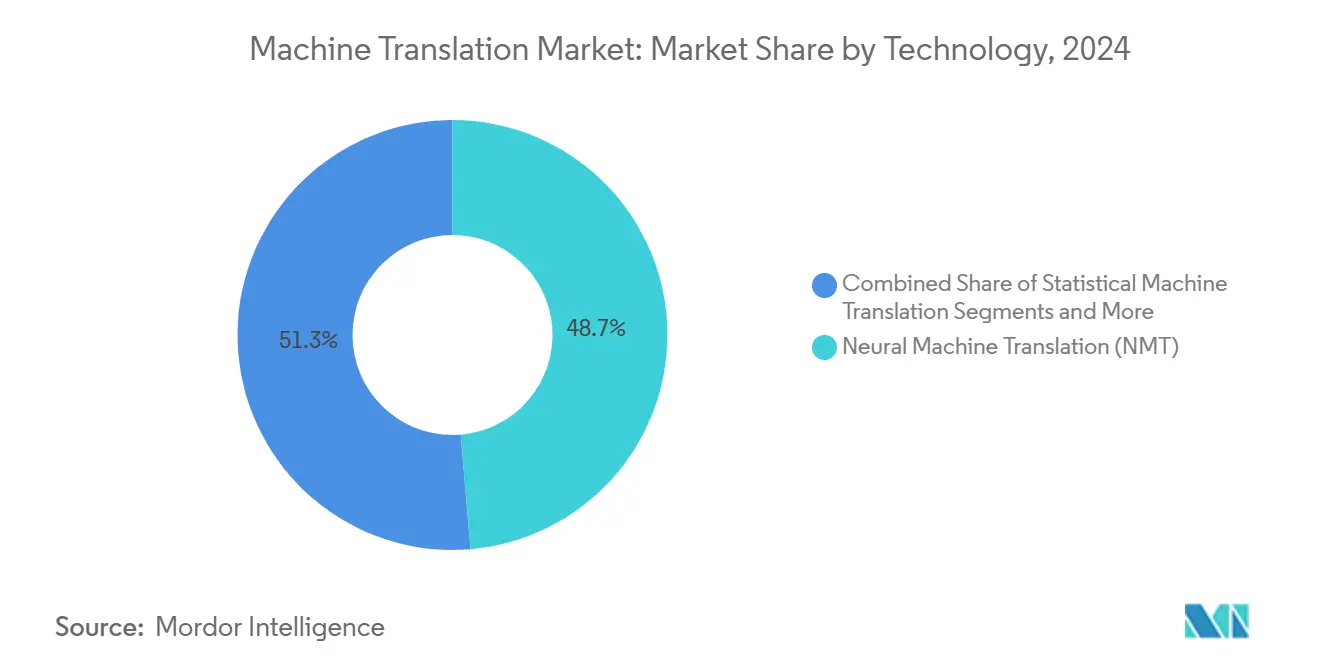
Note: Segment shares of all individual segments available upon report purchase
By Deployment: Cloud Dominance Reflects Enterprise Preferences
Cloud gateways processed 62.34% of machine translation market transactions in 2024, reflecting CIO preference for subscription pricing and elastic throughput. Serverless APIs integrate with CMS, e-commerce, and contact-center stacks, enabling instant language support across all touchpoints. Automatic model refresh shields clients from retraining responsibility, lowering entry barriers for mid-size firms. Conversely, on-premise deployments retain a 37.66% share inside hospitals, banks, and defense agencies that cannot ship protected data to external servers. Edge nodes and hybrid clouds now blur boundaries, letting enterprises pre-process sensitive text locally before forwarding anonymized strings for cloud inference.
The cloud subsegment is forecast to post an 11.87% CAGR through 2030, buoyed by regional data-center expansion and sovereign-cloud initiatives that satisfy localization laws. GPU-based instances tuned for MT workloads lower per-million-character fees, broadening access for start-ups and NGOs. Meanwhile, hardened on-prem appliances evolve to support offline updates, ensuring compliance without performance stagnation. Buyers increasingly weigh latency budgets and audit requirements when choosing between deployment options, further segmenting the growing machine translation market.
By End-User Vertical: Healthcare Accelerates Amid Compliance Demands
IT and Telecom absorbed 26.45% of the machine translation market size in 2024 as software firms globalized product suites and telecom operators launched multilingual self-care portals. Internal localization of API documentation and developer portals fuels steady volume. Healthcare and Life Sciences, although smaller, show the highest 13.89% CAGR as regulators mandate patient-facing documents in native languages. US device filings now embed side-by-side MT output to expedite FDA approvals, while European clinics deploy translation kiosks for immigrant populations.
Retail and e-commerce maintain sizeable throughput translating price lists, reviews, and dynamic ads that pivot during flash sales. Automotive adoption intensifies with connected dashboards requiring instant translation of alerts and navigation prompts. BFSI leverages MT for cross-border compliance disclosures and multilingual KYC outreach. Government portals rely on MT to fulfill right-to-information statutes across official dialects. Educational technology taps real-time captioning to widen reach for MOOCs. Each vertical values different metrics, latency in gaming, traceability in legal, compelling vendors to diversify feature roadmaps, and widening the overall machine translation market.
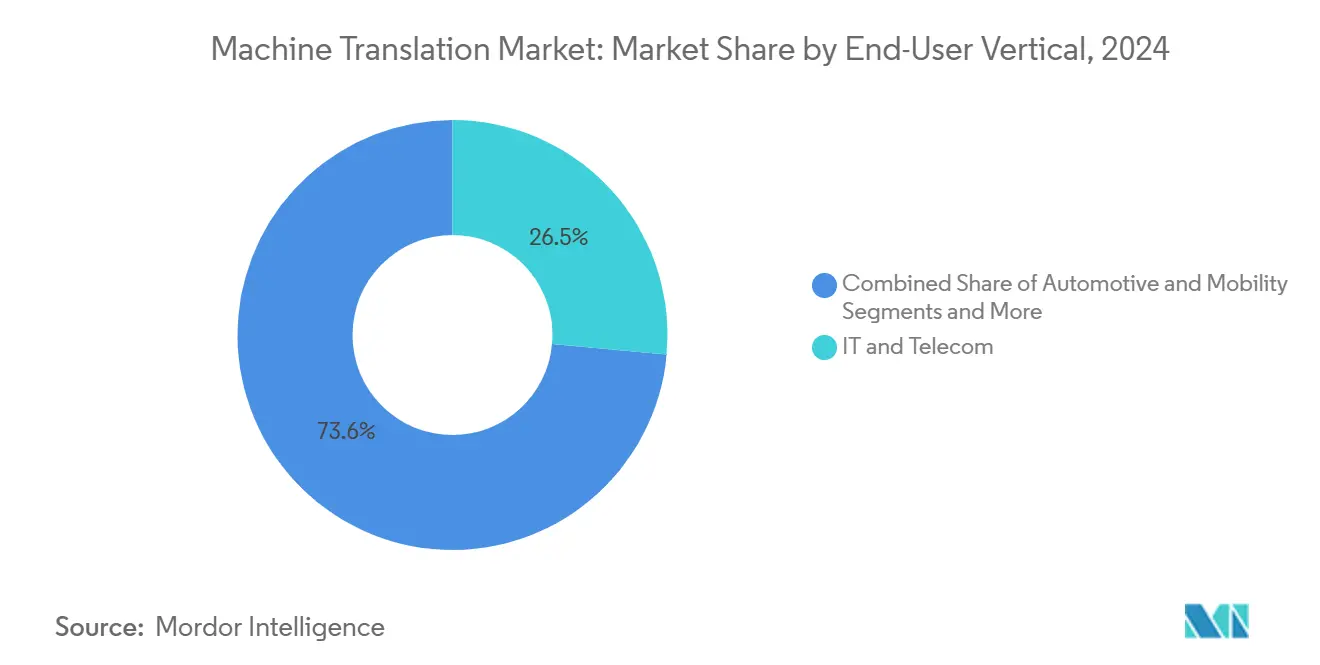
Note: Segment shares of all individual segments available upon report purchase
Geography Analysis
North America’s machine translation market size leadership stems from enterprise SaaS penetration and a supportive VC ecosystem that rewarded DeepL with a multi-billion-dollar valuation after showcasing measurable BLEU gains in legal texts. Stringent HIPAA and financial-privacy rules drive on-prem demand, yet public-cloud adoption rises as AWS, Azure, and Google secure FedRAMP and SOC 2 certifications. The region also hosts the majority of MT patent filings, underscoring innovation centrality.
Asia Pacific’s growth pace reflects sovereign AI funding, 5G rollout, and manufacturing digital twins that depend on real-time localization. Tencent and Baidu secure provincial grants for model pretraining, ensuring their engines meet content-filtering regulations while delivering competitive accuracy. Japanese automakers run bilingual infotainment in production vehicles, and South Korean electronics brands bundle live-chat MT inside warranty apps, reinforcing demand.
Europe occupies the middle ground where regulatory rigor meets expansive language portfolios. The EU AI Act imposes transparency on high-risk MT applications, spurring demand for explainable architectures that log decision paths. Germany’s export-driven manufacturers localize technical documents into dozens of languages to meet after-sales service obligations. Nordic media firms experiment with real-time dubbing to broaden streaming reach, reflecting cultural preferences for subtitled over dubbed content.
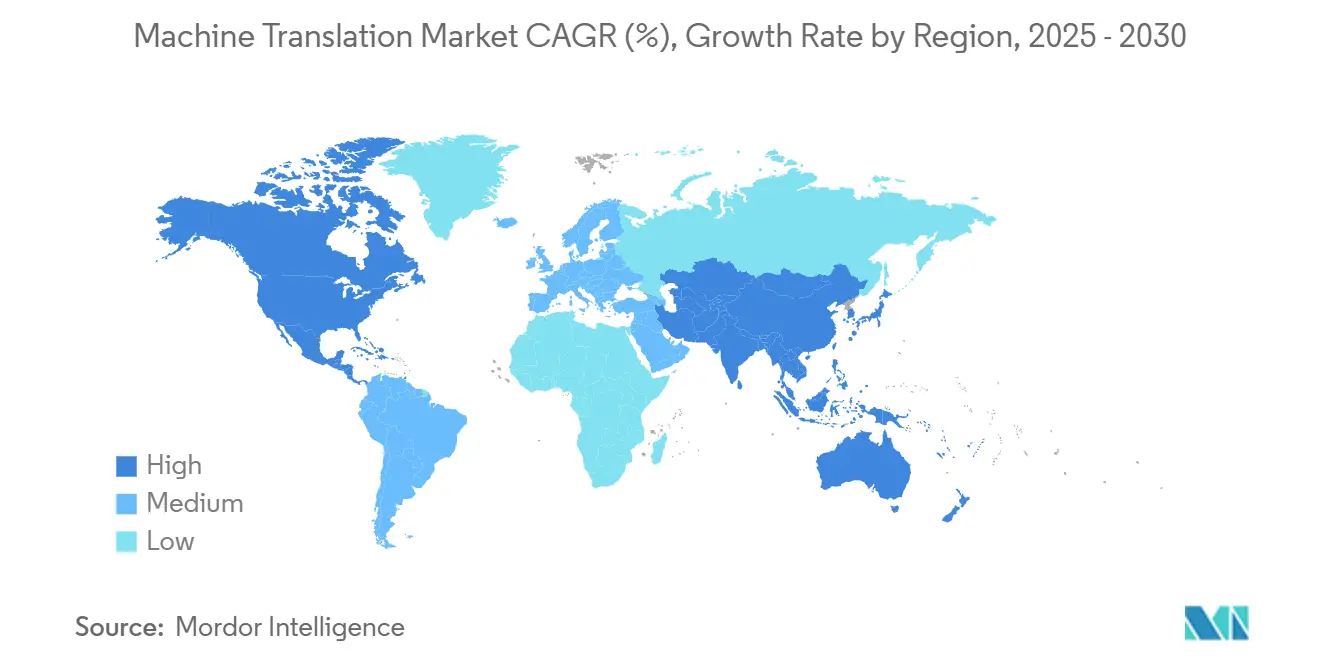
Competitive Landscape
Global competition is moderate, with cloud hyperscalers standing alongside niche specialists. Google, Microsoft, and Amazon capitalize on hyperscale infrastructure and proprietary data lakes, refreshing models at quarterly cadence to keep baseline accuracy moving upward. DeepL differentiates via domain-specific quality gains, especially in Germanic and Romance language pairs, winning enterprise pilots that reward demonstrable error reductions. Tencent and Baidu achieve national-security accreditation, securing public-sector contracts inaccessible to foreign rivals.
Strategic moves focus on vertical integration and ecosystem embedding. Microsoft’s Azure Cognitive Services package bundles MT with speech, OCR, and sentiment APIs, encouraging developers to stick within the cloud account already used for storage and compute. Google embeds Translate APIs into Workspace, driving sticky usage among knowledge workers. Niche players court regulated sectors by offering on-prem appliances with air-gap security, meeting defense and healthcare procurement standards.
Mergers and funding rounds reshape dynamics. ChapsVision’s takeover of SYSTRAN expands a defense-oriented MT portfolio, while RWS’s revenue shows how language-service providers monetize hybrid human-machine workflows through subscription post-editing tools. Competitive edge now hinges on continuous-learning pipelines that update glossaries on the fly, as well as energy-efficient model architecture that trims operating expenditure in light of rising power costs. The resulting environment supports steady innovation but prevents any single vendor from locking in the entire machine translation market.
Machine Translation Industry Leaders
-
Google LLC
-
Microsoft Corporation
-
Amazon Web Services Inc.
-
DeepL GmbH
-
IBM Corporation
- *Disclaimer: Major Players sorted in no particular order
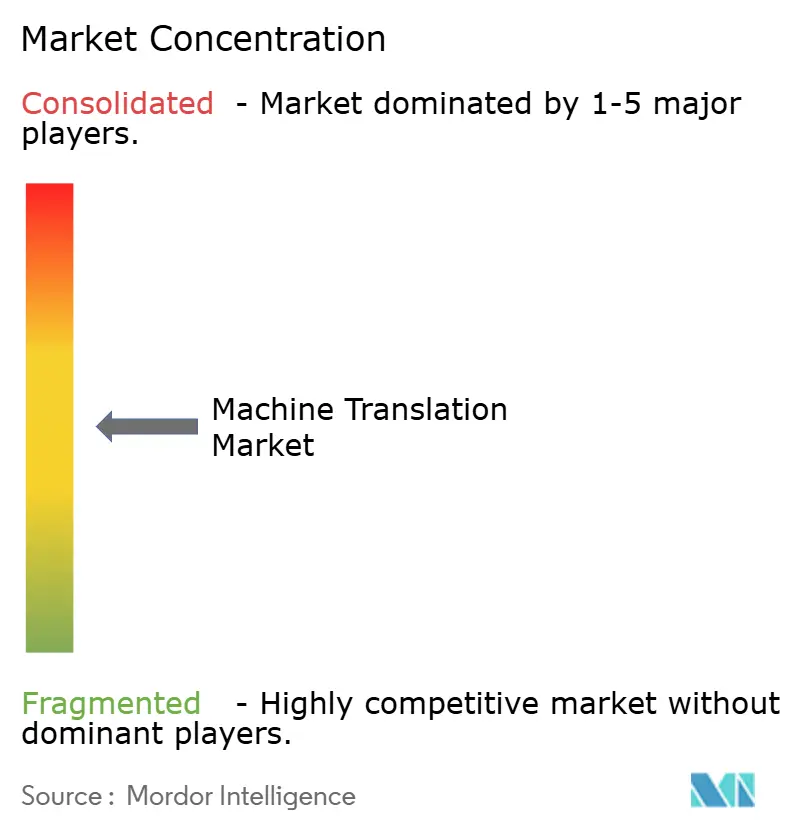
Recent Industry Developments
- June 2025: Apple launched on-device Live Translation in iOS 26 across 12 language pairs, underscoring mobile MT’s privacy and latency advantages.
- December 2024: RWS Holdings reported GBP 718.2 million revenue for FY 2024, with AI-powered translation accounting for 25% of sales, validating hybrid revenue models.
- May 2024: DeepL raised USD 300 million in Series B funding at a USD 2 billion valuation to speed product R&D and global sales expansion.
- January 2024: ChapsVision acquired SYSTRAN International to broaden secure on-premise neural MT capabilities for defense and government clients.
Global Machine Translation Market Report Scope
Machine translation (MT) refers to fully automated software that can translate source content into target languages. Humans may use MT to help them render text and speech into another language; The MT software may operate without human intervention. MT tools are often used to translate vast amounts of information, involving millions of words that could not be translated the traditional way. The quality of MT output can vary considerably, and MT systems require training in the desired domain and language pair to increase quality.
The Machine Translation Market is segmented by Technology (Statistical Machine Translation, Rule-based Machine Translation, and Neural Machine Translation), Deployment (On-premise and Cloud), End-user Vertical (Automotive, Military and Defense, Healthcare, IT, and E-commerce), and Geography (North America, Europe, Asia-Pacific, and the Rest of the World). The market sizes and forecasts are provided in terms of value (USD) for all the above segments.
| Statistical Machine Translation (SMT) | |
| Rule-based Machine Translation (RBMT) | |
| Neural Machine Translation (NMT) | Sequence-to-Sequence NMT |
| Transformer-based NMT | |
| Hybrid and Adaptive MT | |
| Other Technologies |
| On-premise |
| Cloud-based |
| Automotive and Mobility |
| Military and Defense |
| Healthcare and Life-sciences |
| IT and Telecom |
| E-commerce and Retail |
| Media and Entertainment |
| BFSI |
| Government and Public Sector |
| Education and E-learning |
| Other End-user Verticals |
| North America | United States |
| Canada | |
| Mexico | |
| South America | Brazil |
| Argentina | |
| Rest of South America | |
| Europe | Germany |
| France | |
| United Kingdom | |
| Russia | |
| Rest of Europe | |
| Asia Pacific | China |
| Japan | |
| India | |
| South Korea | |
| Rest of Asia Pacific | |
| Middle East | United Arab Emirates |
| Saudi Arabia | |
| Turkey | |
| Rest of the Middle East | |
| Africa | South Africa |
| Nigeria | |
| Rest of Africa |
| By Technology | Statistical Machine Translation (SMT) | |
| Rule-based Machine Translation (RBMT) | ||
| Neural Machine Translation (NMT) | Sequence-to-Sequence NMT | |
| Transformer-based NMT | ||
| Hybrid and Adaptive MT | ||
| Other Technologies | ||
| By Deployment | On-premise | |
| Cloud-based | ||
| By End-user Vertical | Automotive and Mobility | |
| Military and Defense | ||
| Healthcare and Life-sciences | ||
| IT and Telecom | ||
| E-commerce and Retail | ||
| Media and Entertainment | ||
| BFSI | ||
| Government and Public Sector | ||
| Education and E-learning | ||
| Other End-user Verticals | ||
| By Geography | North America | United States |
| Canada | ||
| Mexico | ||
| South America | Brazil | |
| Argentina | ||
| Rest of South America | ||
| Europe | Germany | |
| France | ||
| United Kingdom | ||
| Russia | ||
| Rest of Europe | ||
| Asia Pacific | China | |
| Japan | ||
| India | ||
| South Korea | ||
| Rest of Asia Pacific | ||
| Middle East | United Arab Emirates | |
| Saudi Arabia | ||
| Turkey | ||
| Rest of the Middle East | ||
| Africa | South Africa | |
| Nigeria | ||
| Rest of Africa | ||
Key Questions Answered in the Report
What is the current value of the machine translation market?
The market stands at USD 1.12 billion in 2025 and is projected to double by 2030.
Which technology segment dominates MT adoption?
Neural Machine Translation holds 48.67% market share thanks to transformer-based accuracy.
Which deployment model is expanding quickest?
Cloud-based MT shows an 11.87% CAGR forecast as enterprises favor scalable APIs over on-premise servers.
Why is healthcare a key growth vertical?
Regulatory mandates for multilingual patient communication push Healthcare and Life Sciences to a 13.89% CAGR.
Which region is expected to grow fastest through 2030?
Asia Pacific leads with a 13.40% CAGR driven by China’s sovereign AI programs and Japan’s manufacturing localization needs.
Who are the major players in the competitive landscape?
Google, Microsoft, Amazon, DeepL, and Tencent lead the market, holding a combined 55% share.
Page last updated on:
